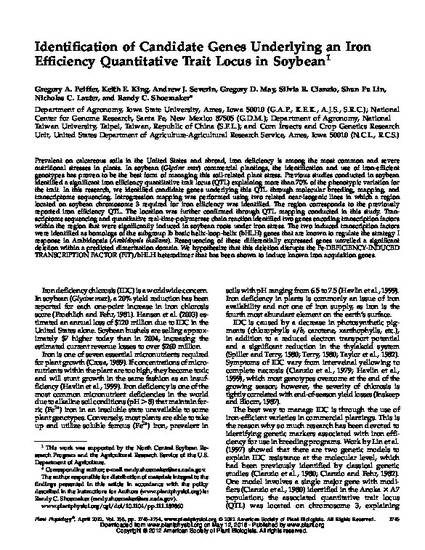
Prevalent on calcareous soils in the United States and abroad, iron deficiency is among the most common and severe nutritional stresses in plants. In soybean (Glycine max) commercial plantings, the identification and use of iron-efficient genotypes has proven to be the best form of managing this soil-related plant stress. Previous studies conducted in soybean identified a significant iron efficiency quantitative trait locus (QTL) explaining more than 70% of the phenotypic variation for the trait. In this research, we identified candidate genes underlying this QTL through molecular breeding, mapping, and transcriptome sequencing. Introgression mapping was performed using two related near-isogenic lines in which a region located on soybean chromosome 3 required for iron efficiency was identified. The region corresponds to the previously reported iron efficiency QTL. The location was further confirmed through QTL mapping conducted in this study. Transcriptome sequencing and quantitative real-time-polymerase chain reaction identified two genes encoding transcription factors within the region that were significantly induced in soybean roots under iron stress. The two induced transcription factors were identified as homologs of the subgroup lb basic helix-loop-helix (bHLH) genes that are known to regulate the strategy I response in Arabidopsis (Arabidopsis thaliana). Resequencing of these differentially expressed genes unveiled a significant deletion within a predicted dimerization domain. We hypothesize that this deletion disrupts the Fe-DEFICIENCY-INDUCED TRANSCRIPTION FACTOR (FIT)/bHLH heterodimer that has been shown to induce known iron acquisition genes.
Available at: http://works.bepress.com/andrew-severin/7/

This article is from Plant Physiology 158 (2012): 1745–1754, doi:10.1104/pp.111.189860.